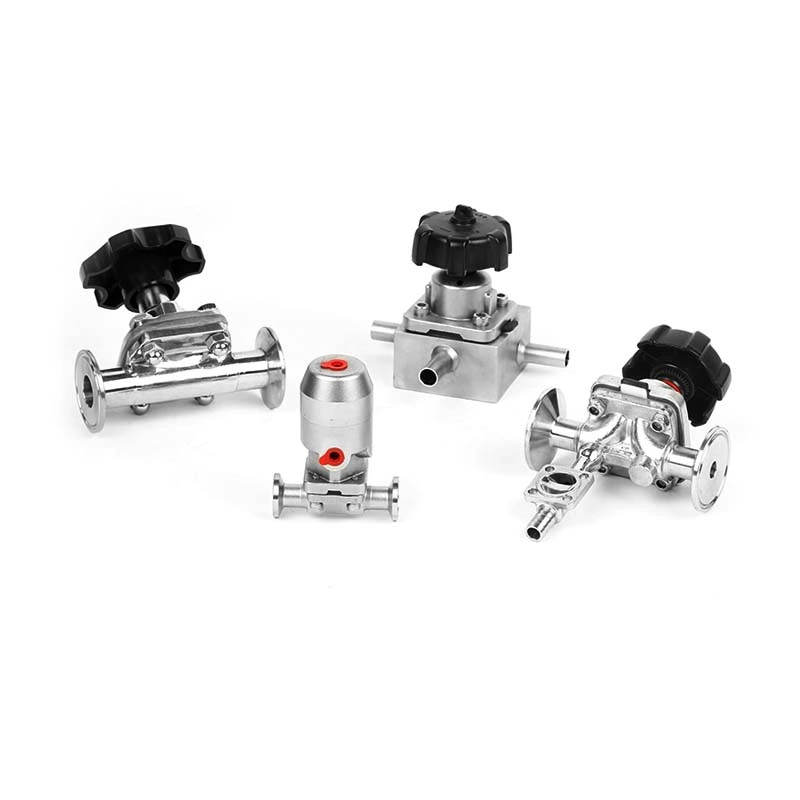Part 2: Principle Of Sanitary Diaphragm Valve
The Sanitary Diaphragm Valve is a fascinating topic, involving a unique mechanical structure and fluid control logic. It plays a crucial role in various industrial and civilian applications.
First, let's discuss the principles and steps of the Rotarex diaphragm valve. Its core component is the diaphragm. To open a diaphragm valve manually, a person turns a handwheel, which drives a connected transmission component, such as a screw. This screw acts like a small lever, transmitting the force of the handwheel to the diaphragm. In a pneumatic diaphragm valve, an air compressor compresses air and pipes it into the valve's air chamber. This compressed air, like a group of anxious people rushing to a destination, rushes into the chamber and pushes the diaphragm. Electric diaphragm valves rely on the power of a motor. The motor-driven components, like a locomotive pulling a train, transmit force to the diaphragm. The diaphragm deforms under this force. In the open state, the diaphragm moves upward or sideways, opening the passage inside the valve. The fluid, like a group of small animals released, flows happily through the passage. When closing, the actuator reverses its action, causing the diaphragm to return to its original position and press firmly against the valve seat, sealing the passage and preventing fluid from passing.
There are several key considerations when operating and maintaining Rotarex diaphragm valves. For example, the diaphragm material should be selected based on the fluid's properties. If handling acidic fluids, just like choosing clothes based on the weather, choose an acid-resistant diaphragm material; otherwise, the diaphragm will corrode easily. The actuator also requires regular maintenance. For example, with pneumatic diaphragm valves, regularly checking the air line for leaks is as important as checking a water pipe for leaks. Furthermore, the valve's installation environment is crucial. If installed in an area subject to significant vibration, like placing a delicate instrument on a shaky table, internal components can easily loosen or become damaged.
Rotarex diaphragm valves offer exceptional safety and stability. The diaphragm separates the fluid from the valve's mechanical transmission, acting like a firewall, preventing harmful substances in the fluid from corroding the transmission components. Imagine, without this diaphragm, it would be like a house without a roof; everything inside would be soaked and damaged by rain. In terms of stability, the diaphragm valve's operating principle ensures it doesn't frequently malfunction due to wear and tear of internal components, unlike some traditional valves. Its diaphragm action is relatively simple and straightforward. As long as the diaphragm maintains good elasticity and strength, it operates stably, like a steady, elderly person, easily resistant to external interference.
This type of diaphragm valve has a wide range of applications. In the water treatment industry, it is frequently used for flow control and purification. Like a gatekeeper, it strictly controls the flow of water in and out. This is because it effectively prevents impurities in the water from contaminating the valve interior and precisely regulates the flow rate. In the petrochemical industry, Rotarex diaphragm valves act like brave warriors, ensuring the safe transfer of flammable, explosive, and highly corrosive fluids through their excellent sealing and corrosion resistance. Their advantages also lie in their cost-effectiveness. Compared to more complex valves, their simple structure means relatively low manufacturing and maintenance costs, making them a highly cost-effective alternative, like an affordable car. At a city sewage treatment plant, Rotarex diaphragm valves play a vital role. Wastewater contains a variety of harmful substances, and ordinary valves are easily corroded. However, the Rotarex diaphragm valve, installed on the sewage pipeline, effectively isolates the sewage from the valve's internal structure through its diaphragm. Over its long-term operation, it stably controls the sewage flow, without leaks or damage from sewage corrosion, acting like a staunch guardian of the sewage treatment process.
With its unique principle and excellent performance, the Rotarex diaphragm valve is an ideal choice for many fluid handling applications.
